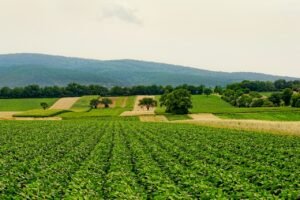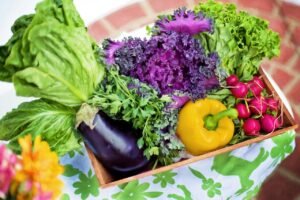
Are you curious about the growing trend of urban farming in London? In this article, we will take you on a journey through London’s bustling streets as we explore the innovative and sustainable practice of urban farming. From abandoned rooftops to disused underground spaces, discover how creative individuals are transforming the cityscape into vibrant and productive agricultural landscapes. Get ready to be inspired by the incredible resilience and resourcefulness of these urban farmers as they cultivate fresh produce and promote a greener future for the capital. Join us as we uncover the fascinating world of urban farming in London.

Benefits of Urban Farming in London
Improving Food Security
Urban farming in London plays a crucial role in improving food security. By cultivating and producing fresh fruits, vegetables, and herbs within the city, urban farming helps to reduce reliance on imported food and ensure a more sustainable and reliable food supply for its residents. This is particularly important in a city like London, where population density is high and access to agricultural land is limited. Urban farming empowers individuals and communities to take control of their food production and contribute to a more secure and resilient food system.
Reducing Carbon Footprint
One of the significant benefits of urban farming in London is its potential to reduce the city’s carbon footprint. By growing food locally, the need for long-distance transportation is minimized, thereby reducing greenhouse gas emissions associated with transportation. Additionally, urban farming promotes the use of sustainable practices such as composting, organic fertilizers, and rainwater harvesting, further reducing reliance on fossil-fuel-based inputs and minimizing environmental impact.
Promoting Sustainable Agriculture
Urban farming is a prime example of sustainable agriculture in action. By utilizing innovative growing techniques such as aquaponics, hydroponics, and vertical farming, urban farmers in London can maximize space efficiency and optimize resource usage. These practices minimize water consumption and eliminate the need for chemical pesticides and fertilizers, promoting a more environmentally friendly approach to agriculture. Urban farmers often prioritize organic and sustainable farming methods, contributing to the overall health and sustainability of the city’s food system.
Enhancing Biodiversity
Urban farming in London provides valuable habitat for pollinators such as bees, butterflies, and birds. Rooftop gardens, community gardens, and allotments act as green oases in the urban landscape, attracting and supporting a diverse range of flora and fauna. By creating these micro-habitats, urban farming helps to enhance biodiversity within the city and contributes to the overall conservation of important ecosystems. Moreover, the presence of urban farms can help raise awareness about the importance of biodiversity and the need for its protection.
Increasing Access to Fresh Produce
One of the most significant benefits of urban farming in London is its ability to increase access to fresh and nutritious produce, especially in areas with limited grocery options. By bringing food production closer to urban populations, urban farming reduces the distance food needs to travel and ensures that residents have access to high-quality, locally grown produce. This is particularly important for low-income communities that may face barriers to accessing fresh food. Through farmers’ markets, community-supported agriculture programs, and direct sales, urban farmers make fresh produce more accessible to all, contributing to improved public health and well-being.
Types of Urban Farming in London
Rooftop Gardens
Rooftop gardens are a popular form of urban farming in London, taking advantage of available space on rooftops of buildings. These gardens are created by installing green roofs or using raised beds and containers to grow a variety of crops, ranging from vegetables and herbs to edible flowers. Rooftop gardens not only provide a productive space for agriculture but also offer numerous benefits such as reducing energy consumption by insulating buildings, mitigating urban heat island effect, and improving air quality by absorbing pollutants.
Community Gardens
Community gardens are spaces where individuals and groups come together to collectively grow and maintain plants. These gardens provide opportunities for social interaction, education, and skill development. They are often located on publicly or privately owned land where participants can rent or cultivate small plots for their use. Community gardens in London foster community spirit and promote social cohesion while providing a platform for urban agriculture and food production.
Vertical Farming
Vertical farming involves growing plants in vertically stacked layers, utilizing vertical space to maximize the production capacity. In London, vertical farming is commonly practiced in indoor environments such as warehouses or repurposed buildings. With the use of artificial lighting, hydroponic or aeroponic systems, and precise environmental controls, vertical farms can achieve high crop yields throughout the year, independent of seasonal variations. This innovative farming technique is highly efficient in terms of space, water, and energy usage.
Indoor Farming
Similar to vertical farming, indoor farming relies on controlled environments to grow crops. However, indoor farming is not limited to vertical structures and can encompass a wide range of setups, including hydroponic systems, aquaponics, and container farms. Indoor farming allows for year-round cultivation, protection from adverse weather conditions, reduced water consumption, and the ability to control pests and diseases without the need for chemical pesticides. This form of urban farming is well-suited to London’s urban landscape, where limited outdoor space is available.
Allotments
Allotments are small plots of land allocated for individuals or community groups to grow their own food. These plots are usually found in designated areas within the city and are managed by local authorities or independent allotment associations. Allotments offer an affordable and accessible option for urban residents to cultivate their own produce. They promote self-sufficiency, provide opportunities for exercise and outdoor recreation, and foster a sense of community among plot holders. Allotments are an integral part of London’s urban farming landscape, popular among both novice and experienced gardeners.

Obstacles to Urban Farming in London
Limited Space
One of the most significant challenges facing urban farming in London is the scarcity of available space. With high population density and a competitive real estate market, finding suitable land for agriculture within the city can be challenging. This limitation forces urban farmers to be creative and seek alternative growing spaces such as rooftops, disused buildings, or small pockets of land. Innovative farming techniques like vertical farming and indoor farming have emerged as viable solutions to overcome the limitations of space in the urban environment.
High Costs
Urban farming in London often faces financial barriers due to high costs associated with land acquisition, infrastructure development, and operational expenses. The limited availability of affordable land within the city, coupled with the need for specialized equipment and technologies, can make starting and operating an urban farm financially burdensome. However, initiatives such as grants, subsidies, and partnerships with local authorities or businesses can help alleviate some of the financial challenges and enable the growth of urban farming.
Legal Considerations
Navigating the legal framework surrounding urban farming can be complex, with regulations and zoning restrictions varying across different areas within London. Depending on the type of urban farming activity, permits, licenses, and compliance with relevant regulations may be required. It is essential for urban farmers to familiarize themselves with local laws and regulations, engage with local authorities, and work towards creating more supportive and inclusive policies for urban agriculture.
Limited Water Resources
Water scarcity is a global concern, and London is no exception. Urban farming requires a reliable water supply for irrigation, but the availability of water resources within the city is limited. To mitigate this challenge, urban farmers are encouraged to adopt water-efficient practices such as drip irrigation, rainwater harvesting, and implementing water-saving technologies. Collaboration with local water authorities and exploring water recycling options can also contribute to sustainable water management in urban farming.
Challenges in Scaling
While small-scale urban farming projects have thrived in London, scaling up operations can present significant challenges. As the demand for locally grown food increases, urban farmers may face difficulties in expanding their production capacity, meeting consistent quality standards, and ensuring efficient distribution. Collaboration and partnerships with other stakeholders in the food system, including wholesalers, retailers, and logistics providers, can help overcome these challenges and facilitate the scaling up of urban farming in London.
Successful Urban Farming Projects in London
The Skip Garden
The Skip Garden, located in the King’s Cross area, is an inspiring example of an urban farming project that combines food production with education and community engagement. The project utilizes repurposed skips (portable containers) as raised beds to grow a variety of vegetables and herbs. The Skip Garden offers educational programs, workshops, and volunteering opportunities, providing a platform for learning and connecting with nature in an urban setting.
Growing Underground
Growing Underground is an innovative urban farming project that utilizes disused underground tunnels in London to cultivate a range of crops, including microgreens and herbs. This underground farm takes advantage of the controlled environment provided by the tunnels, using hydroponic systems and LED lighting to ensure optimum growing conditions. Growing Underground demonstrates how unconventional spaces can be transformed into productive and sustainable agricultural sites.
Roof East
Roof East, situated on top of a multistory car park in Stratford, is a pioneering project that showcases the potential of rooftop farming. This urban farming venture focuses on growing vegetables and salad greens, providing fresh and healthy produce to local residents and businesses. Roof East also offers a range of recreational activities, community events, and educational workshops, making it a vibrant hub for urban farming and social interaction.
Farmopolis
Farmopolis is an urban oasis nestled on the Greenwich Peninsula, featuring a combination of outdoor gardens and indoor greenhouse spaces. This project brings together nature, art, and culture, offering a unique experience where visitors can explore diverse plant species, enjoy live performances, and participate in workshops. Farmopolis demonstrates how urban farming can be seamlessly integrated with public spaces, creating a harmonious environment that nurtures both people and nature.
Urban Growth
Urban Growth is a social enterprise that operates across multiple sites in London, transforming underused spaces into thriving urban farms. They focus on community engagement, offering training programs and employment opportunities in horticulture. Urban Growth’s projects include both rooftop and ground-level farms, demonstrating how urban farming can contribute to social inclusion, skill development, and the creation of vibrant green spaces.

Urban Farming Innovations in London
Aquaponics Systems
Aquaponics is an innovative approach that combines fish farming (aquaculture) and soilless plant cultivation (hydroponics) in a symbiotic system. In London, aquaponics systems have been implemented to maximize productivity in limited spaces. Fish waste provides nutrients for the plants, while the plants filter and purify the water for the fish. This closed-loop system allows for the efficient use of resources and enables year-round production of both fish and crops.
Hydroponic Systems
Hydroponics is a soilless method of growing plants that involves supplying nutrient-rich water directly to the plant roots. This technique has gained popularity in London’s urban farming scene due to its space-efficient nature and water-saving capabilities. Hydroponic systems can be set up indoors, vertically, or in greenhouses, allowing for continuous production of crops in controlled environments. The precise control over nutrient levels and irrigation makes hydroponics an efficient and sustainable farming method.
Vertical Farming Technologies
Vertical farming technologies have revolutionized urban agriculture by enabling the cultivation of crops in vertically stacked layers. In London, vertical farming technologies are often integrated into indoor farming setups, utilizing artificial lighting, climate control systems, and automated processes to optimize plant growth. The controlled environment offered by vertical farming eliminates seasonal limitations, reduces water usage, and allows for high-density production while minimizing the use of pesticides.
Smart Greenhouses
Smart greenhouses utilize technology and automation to create an optimized growing environment for crops. In London, smart greenhouse systems have been implemented to maximize energy efficiency, control temperature and humidity levels, and optimize resource usage. Features such as light sensors, automated irrigation systems, and climate control technologies enable precise monitoring and adjustment of environmental conditions, resulting in higher crop yields and reduced resource wastage.
Precision Agriculture
Precision agriculture involves the use of advanced technologies such as sensors, drones, and data analytics to monitor and manage agricultural practices more accurately. In London, precision agriculture techniques have been adopted to enhance urban farming operations. Soil sensors and remote monitoring systems allow farmers to optimize fertilization and irrigation, while drones provide valuable data for crop health assessment. By leveraging technology, urban farmers can improve efficiency, reduce waste, and make data-driven decisions for sustainable farming practices.
Community Engagement in Urban Farming
Educational Programs
Educational programs play a vital role in engaging the community in urban farming. Workshops, courses, and training sessions on topics such as gardening, sustainable agriculture, and food production can empower individuals with the skills and knowledge to start their own urban farms or participate in community gardening initiatives. Learning opportunities for all age groups, from school children to adults, contribute to building a more sustainable and food-secure city.
Volunteer Opportunities
Volunteering in urban farming projects not only supports the work of local farmers but also provides an opportunity for individuals to connect with nature, learn about agriculture, and contribute to their community. Urban farms often rely on volunteers for tasks such as planting, harvesting, weeding, and maintaining the farm infrastructure. Volunteering in urban farming projects can be a rewarding experience that fosters a sense of belonging and encourages active participation in sustainable food systems.
Supporting Local Food Banks
Urban farming can make a significant contribution to addressing food insecurity by partnering with local food banks and community organizations that distribute food to those in need. By donating surplus produce and establishing direct relationships with food banks, urban farmers can ensure that fresh and nutritious food reaches vulnerable populations. Such collaborations enable urban farming to have a positive social impact, promoting access to healthy food for all members of the community.
Collaborations with Schools
Urban farming initiatives can also engage with schools and educational institutions to foster a culture of sustainability and food literacy among young people. Collaborations between urban farms and schools can include joint gardening projects, field trips to urban farms, or integrating food production into the school curriculum. By involving schools, urban farming can inspire the next generation to develop an appreciation for nature, food production, and sustainable living practices.
Public Events and Workshops
Organizing public events and workshops related to urban farming creates opportunities for the wider community to learn, participate, and connect with local food producers. Farmers’ markets, farm-to-table events, cooking demonstrations, and workshops on topics such as seed-saving or composting bring people together and foster a sense of community around urban farming. These events also provide a platform for urban farmers to showcase their products and share their knowledge, thereby raising awareness about the benefits of localized food production.
Urban Farming Policies and Initiatives in London
London’s Food Strategy
London’s Food Strategy sets out a comprehensive approach to address food-related challenges in the city, including urban farming. The strategy recognizes the importance of supporting urban agriculture and aims to facilitate the growth of urban farms through policy interventions, funding opportunities, and collaboration with relevant stakeholders. By providing a roadmap for sustainable food systems, London’s Food Strategy creates a supportive framework for urban farming initiatives and advocates for a resilient and inclusive food system.
London Plan’s Green Infrastructure
The London Plan’s Green Infrastructure policy promotes the integration of urban farming and green spaces into the city’s design and planning process. This policy recognizes the multiple benefits of urban farming, including food production, biodiversity enhancement, and climate change mitigation. It encourages the incorporation of green roofs, community gardens, and allotments in new developments, ensuring that future urban infrastructure includes space for agriculture and greenery.
Mayor’s Air Quality Fund
The Mayor’s Air Quality Fund supports projects that contribute to improving air quality in London, including urban farming initiatives. By recognizing the role of urban farming in mitigating air pollution and improving local air quality, the fund provides financial support for innovative projects that integrate farming into the urban environment. This support ranges from funding for start-up urban farms to research and development of sustainable farming technologies specifically designed for urban areas.
Community Land Trusts
Community Land Trusts (CLTs) promote community-led and sustainable development by acquiring and managing land for the benefit of the community. CLTs can play a crucial role in securing land for urban farming purposes and ensuring its long-term availability for agricultural use. By working with CLTs, urban farming projects can access affordable land, benefit from community involvement, and contribute to the creation of thriving and sustainable neighborhoods.
Bee-friendly City Campaign
The Bee-friendly City Campaign in London aims to create a bee-friendly environment by promoting pollinator-friendly practices and protecting habitats for bees and other pollinators. Urban farming plays a vital role in supporting pollinators by providing a diverse range of flowering plants and creating green spaces in the city. Collaborations between urban farms, community gardens, and the Bee-friendly City Campaign can enhance biodiversity and contribute to the conservation of vital pollinator species.
Challenges for Urban Farming in the London Underground
Lack of Natural Light
The London Underground poses a significant challenge for urban farming due to its limited access to natural light. Plants require sufficient sunlight for photosynthesis and healthy growth, and the lack of direct sunlight underground can hinder crop productivity. Implementing artificial lighting systems, such as LED grow lights, is necessary to supplement the plants’ light requirements and ensure adequate growth. However, the energy consumption and cost implications of artificial lighting can be significant challenges for farming in the London Underground.
Limited Space
Space constraints are another substantial obstacle for urban farming in the London Underground. Underground tunnels and stations have limited areas available for agriculture, making it challenging to scale up operations and meet demand. Innovative farming systems such as vertical farming or hydroponics can maximize space utilization, but the limited square footage remains a limiting factor. Creative utilization of available space, compact growing techniques, and efficient use of vertical space can help overcome this challenge to some extent.
Ventilation Issues
Ventilation poses a challenge in the London Underground, where temperature and humidity control are crucial for successful plant growth. Underground spaces often lack natural ventilation, resulting in stagnant air and high humidity levels. Poor air circulation can lead to the development of fungal diseases and affect the overall health of the crops. Implementing a robust ventilation system that circulates fresh air, removes excess moisture, and maintains optimal temperature is critical for ensuring the success of urban farming projects in the London Underground.
Safety Concerns
Farming in the London Underground raises safety concerns that must be thoroughly addressed. Underground environments present unique challenges related to fire safety, access to emergency exits, and the availability of evacuation routes in the event of an emergency. Conducting safety assessments, implementing proper fire prevention measures, and ensuring compliance with safety regulations are essential steps for mitigating the risks associated with urban farming in underground spaces.
Maintaining Temperature and Humidity
Maintaining optimal temperature and humidity levels is critical for successful plant growth. The London Underground’s underground environment may present challenges in achieving the necessary conditions for different crops. Temperature control systems, insulation, and moisture regulation mechanisms become vital to ensuring a stable and conducive environment for crop cultivation. Advanced climate control technologies that can adapt to the specific conditions of the underground environment may be required to mitigate temperature and humidity-related challenges.
Future of Urban Farming in London
Expansion of Green Spaces
The future of urban farming in London involves the expansion of green spaces to accommodate increased food production. Rooftop gardens, community gardens, and green walls will become more prevalent as city planners recognize the value of integrating agriculture and green infrastructure. Utilizing underused spaces, converting derelict sites, and incorporating farming into new developments will facilitate the growth of urban farming and contribute to a greener and more sustainable city.
Integration of Farming into Urban Design
In the future, urban design will place greater emphasis on incorporating farming into the fabric of the city. Buildings will be designed with integrated green spaces, rooftop gardens, and vertical farming systems. Architects and urban planners will work together to create innovative designs that seamlessly integrate agricultural spaces into urban environments. This integration will not only enhance the visual appeal of the city but also contribute to food production and community engagement.
Technological Advancements
The future of urban farming in London will be driven by technological advancements that optimize resource usage and increase productivity. Innovations in automation, robotics, artificial intelligence, and data analytics will transform farming practices, making them more efficient and sustainable. From automated harvesting systems to sensors that monitor plant health, technology will play a pivotal role in overcoming the challenges of urban farming and maximizing its potential.
Increased Collaboration and Support
The future of urban farming in London hinges on increased collaboration and support from various stakeholders. Collaboration between urban farmers, local authorities, businesses, and community organizations will be crucial in creating a supportive ecosystem for urban agriculture. Sharing knowledge, resources, and best practices, as well as providing access to funding and training opportunities, will enable urban farmers to overcome challenges and thrive in their endeavors.
Policy and Regulatory Revisions
As urban farming continues to gain momentum, policymakers and regulators will need to revise existing policies and regulations to create a conducive environment for its growth. Allocating land, providing financial incentives, simplifying bureaucratic processes, and streamlining regulations related to land use and water management will be essential steps in supporting and promoting urban farming in London. An enabling policy framework will enhance the viability and scalability of urban farming projects and ensure their long-term sustainability.
Conclusion
Urban farming in London offers numerous benefits for the city, including improved food security, reduced carbon footprint, enhanced biodiversity, and increased access to fresh produce. Despite the obstacles posed by limited space, high costs, and legal considerations, successful urban farming projects have emerged in the form of rooftop gardens, community gardens, vertical farms, and more. Innovations such as aquaponics, hydroponics, and smart greenhouse technologies have transformed urban farming, while community engagement and supportive policies have further accelerated its growth. While challenges persist in farming the London Underground, advancements in technology and sustainable urban design provide hope for the future. The expansion of green spaces, integration of farming into urban design, and increased collaboration and support will pave the way for a thriving and sustainable urban farming sector. With policy and regulatory revisions, London has the potential to become a global leader in urban farming, setting an example for other cities around the world.







